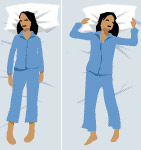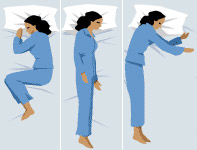We all have our habits when it comes to sleeping, but the position we sleep in will always fall into one of three categories: back, side, or stomach. And while some people switch positions more often than others, there’s usually one predominant position during the night (which may be different than the position you prefer to fall asleep in!).
It’s this predominant position that should guide you when you’re shopping for a new mattress.
So, below are a few things to think about for all types of sleepers.
Back Sleeper Considerations
 It goes without saying that people who sleep on their backs are more susceptible to pain in the spine and the back in general. This is because of the amount of strain your spine undergoes when you lie down. It might seem like that old spring mattress you’ve had for many years feels great when you first lay your head to rest, but as the night wears on the pressure on your spine increases.
It goes without saying that people who sleep on their backs are more susceptible to pain in the spine and the back in general. This is because of the amount of strain your spine undergoes when you lie down. It might seem like that old spring mattress you’ve had for many years feels great when you first lay your head to rest, but as the night wears on the pressure on your spine increases.
The first step towards solving this problem is understanding that, as a back sleeper, you will need more support than someone who says, sleeps on their side. For this reason, if you’re on the market for a new mattress (and of course, I recommend memory foam), it’s wise to look for a model that’s medium-firm or slightly plusher than most. However, going too plush can also pose it’s problems because you need more support for your spine than people who sleep in a different position do.
It may all start to sound very confusing and I understand how you feel. After all, it wasn’t that long ago I was in the same situation.
You do have to think about how heavy you are, what you do and don’t find comfortable, and the fact you may need to consider motion transfer if you share your bed with someone else.
Choosing a new mattress can be a journey in itself, but if you understand that, as a back sleeper, it’s your spine that needs a little extra help, this should narrow down the choice (if only a little).
Side Sleeper Considerations
 If you sleep on your side, you may be happy to know this is one of the healthiest positions. Sleeping in this position, for one thing, will help reduce acid reflux. This is why your doctor might tell you sleeping on your side is better for you if you’re pregnant.
If you sleep on your side, you may be happy to know this is one of the healthiest positions. Sleeping in this position, for one thing, will help reduce acid reflux. This is why your doctor might tell you sleeping on your side is better for you if you’re pregnant.
It also means the blood can circulate better and it reduces the amount of pressure on your lungs. Think about it? If you have a partner that snores, the chances are this is at its worst when they sleep on their back. For the most part, a snoring partner can be pretty much silenced by helping them to turn on their side.
However, it’s not all “plain sailing” if you sleep on your side. If you have a traditional spring mattress, for instance, this won’t help in terms of pressure points across your body. This is why a memory foam mattress can do wonders for your posture even if you do sleep on your side.
The main problems side sleepers will come across are aches and pains in the shoulders and hips. If you make sure your mattress will adequately cradle these parts of your body you won’t wake up feeling like you’ve aged 10 years overnight. Of course, the thickness, type of memory foam, and density you choose are entirely up to you. In fact, I would say this is a very personal decision.
Just bear in mind that if you generally sleep on your side, it’s worth looking into medium to soft memory foam mattresses specifically designed to support hips, shoulders, and to a certain degree the spine, as these are the areas where the most pressure is experienced when you sleep.
Stomach Sleeper Considerations
 This might seem like the most comfortable position for you, but this is actually one of the unhealthiest ways to drop off overnight. The main reason for this is the majority of our weight falls on the torso area, and when you sleep on your stomach you’re actually putting an awful lot of pressure on your spine because of this.
This might seem like the most comfortable position for you, but this is actually one of the unhealthiest ways to drop off overnight. The main reason for this is the majority of our weight falls on the torso area, and when you sleep on your stomach you’re actually putting an awful lot of pressure on your spine because of this.
But since the last thing you will probably want to hear is that you should change your sleeping position, it’s important you know what can be done to help alleviate the strain on your spine. The first thing to consider is how well your current mattress is supporting you.
If you find you suffer from more aches and pains in your back when you wake up in the morning, your mattress could be the culprit. Coil spring mattresses are probably the last thing you should sleep on because they’re not designed to support the pressure points across the body (let alone help align your spine).
So if your mattress is a number of years old, then for the sake of your physical health it might be time to change.
The best type of mattress for someone who sleeps on their stomach is not too firm, yet not too soft. If you go too soft, the spine will arch as you sleep and this can be very painful the next morning. If you have a mattress that’s too firm this won’t let your spine fall into its natural curve and will also cause you problems.
In general, though, stomach sleepers should look for a mattress that’s more firm than plush.
It’s not easy because everyone has their own personal preference when choosing a mattress that suits them best, but honestly, as someone who sleeps on their stomach, you really have to make sure you get the right support.
Additional Info
I do have more information on my website that might help. If you are thinking about a memory foam mattress, my section on mattress density is a good source of information when deciding which type will suit you best.
Your pillow is something else worth thinking about since this will affect the overall position you eventually fall asleep in. If you would like more information on this, feel free to take a look at my informational page on pillows. There is also a really handy video to help make things clearer.
